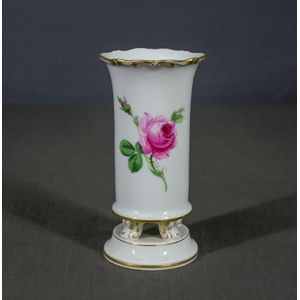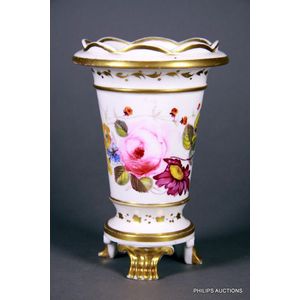Handpainted Floral Bone China Vase, c1830
You must be a subscriber, and be logged in to view price and dealer details.
Subscribe Now to view actual auction price for this item
When you subscribe, you have the option of setting the currency in which to display prices to $Au, $US, $NZ or Stg.
- Cartouche - An ornamental panel in the form of of a shield, oval or rectangular scroll with curling edges. It may be carved into the back of a chair or the top of a sideboard, or present on a piece of silver or jewellery, and contain the initials of the original owner, heraldic symbols, or some other inscription, such as the details of a presentation.
In ceramics the term defines the central area of a vase or similar with a decorative border in one of the shapes above, into which a decorative scene or figures have been painted. - Bone China - Bone china, Also called 'English china", is one of the three types of porcelain, the other two being soft paste porcelain and hard paste porcelain.
Porcelain is an ancient ceramic material, first made in China, hence the common name "china", and the introduction of bone china was to counter the imports of Chinese porcelain.
The initial development of bone china is credited to Josiah Spode, who introduced it around 1800 and it was soon after copied by other manufacturers including Minton, Coalport, Davenport, Derby, Worcester, Wedgwood and Rockingham and the Herculaneum factory at Liverpool.
Spode's bone china was made by mixing ash from cattle bones with feldspar and kaolin, which created a material that was stronger, more translucent, and whiter than traditional porcelain. He began to produce this new type of porcelain in 1796 and it quickly became very popular.
At the time, the process and ingredients were kept secret and were only known to a few manufacturers and were protected by patents.
In the 19th century, bone china became increasingly popular and was widely produced by many manufacturers in England. During this time, it was considered a luxury item and was often used to create fine dining sets and other decorative items.
Bone china is still used in the production of fine porcelain wares, such as tea sets, figurines, and other decorative pieces. His basic formula of six parts bone ash, four parts china stone, and three and a half parts china clay remains the standard English body. It is still considered a luxury item due to its strength, translucency, and whiteness, and is often used for high-end and high-quality porcelain. China.
This item has been included into following indexes:
Visually similar items

Meissen porcelain posy vase. Hand painted rose decoration. Pierced quad footed column. Crossed swords mark & dates '1710 .1910,' to base. Height 14 cm

A floral tripod based spill vase, circa 1825, Staffordshire made, of conical shape with a flaring lip and upright scalloped rim, waisted and decorated with applied bands and continuous floral decoration upon a white ground; unmarked, height 15 cm

Early 19th century small spill vase, attributed to Flight Barr and Barr Worcester, with cobalt blue ground and hand painted seashell decoration, 9.5 cm high, Ref: Flight and Barr Worcester Porcelain 1783-1840 by Henry Sandon, The Antique Collector's Club,

Copeland & Garrett blue ribbon vase in the Sevres style and with hand painted floral, sequential mid section, outswept rim and fine gilt detail and trim, a lovely detailed blue ribbon painted to top section, stamped to base, height 15 cm
